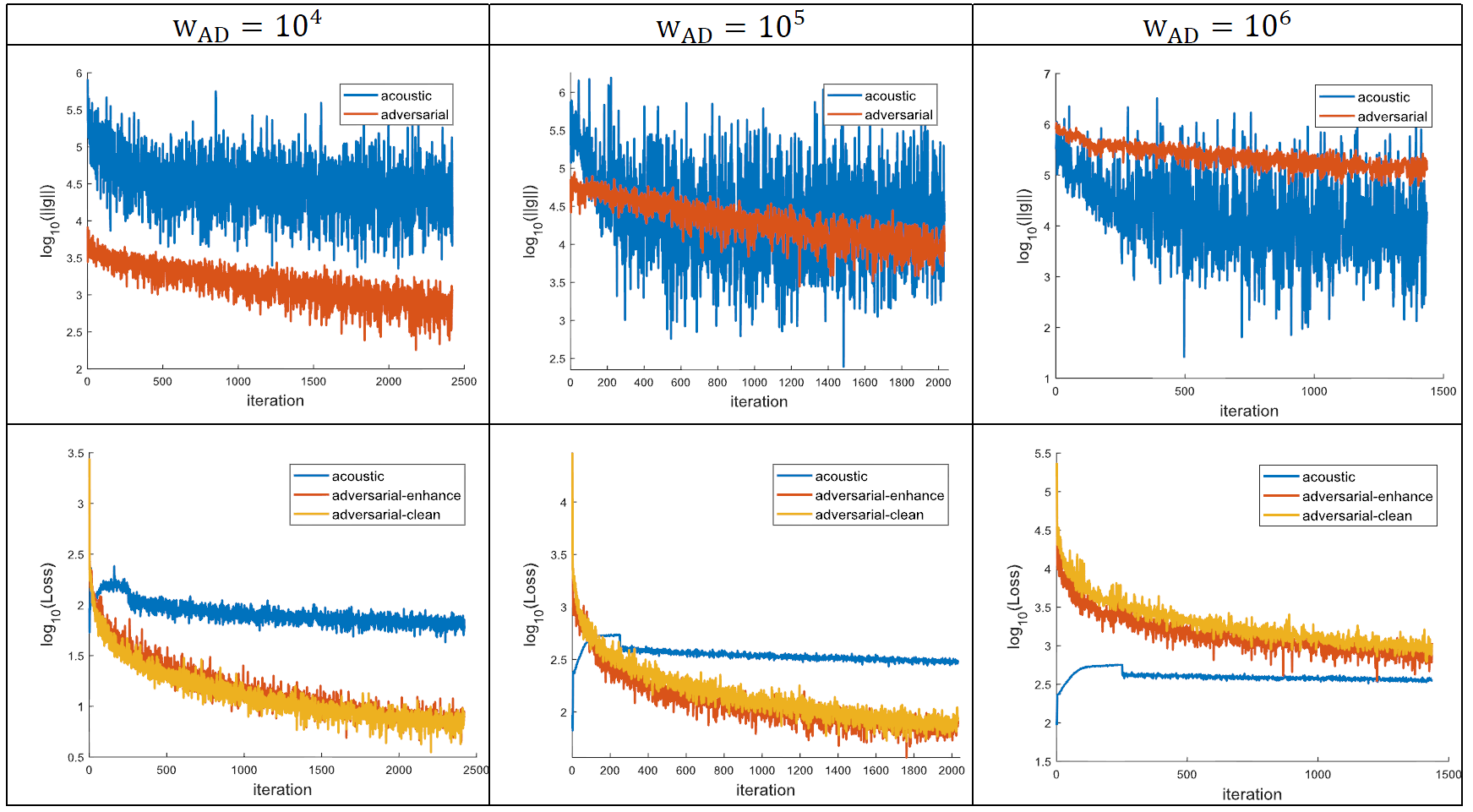This repository contains the code and supplementary result for the paper "Unpaired Speech Enhancement by Acoustic and Adversarial Supervision" (IEEE Signal Processing Letters, 2019).
paper available at https://arxiv.org/abs/1811.02182
- Install Warp-CTC, ctcdecode (See https://github.com/SeanNaren/deepspeech.pytorch/#installation).
- Install kenLM (See https://github.com/kpu/kenlm) and download 4-gram trained on librispeech in [here] (http://www.openslr.org/resources/11/4-gram.arpa.gz)
Code for this part is originated from https://github.com/SeanNaren/deepspeech.pytorch/. We modify the feature from spectrogram to log-Mel filterbank output (LMFB), and 2D convolutional layer to 1D convolutional layer.
- cd AM_training
- Install requirements by
pip install -r requirements.txt
We trained acoustic model on Librispeech corpus. To download and setup Librispeech, see https://github.com/SeanNaren/deepspeech.pytorch/#librispeech
You can train the acoustic model used in the paper with command below:
python train.py --gpu 0 --expnum 1 --batch_size 30 --conv_layers 2 --conv_map 128 --conv_kernel 11 --conv_stride 2 --rnn_layers 5 --rnn_size 1000 --lr 1e-4
The pre-trained acoustic model (librispeech_final.pth.tar) can be available in this link.
Generate grapheme probability estimated from the acoustic model on validation data.
python test.py --model_path models/librispeech_final.pth.tar --test_manifest data/libri_val_cl.csv --gpu 0 --output_path decoding/out_valid
Next, beam search by combining AM and 4-gram LM score. Find the optimal (alpha, beta) which achieves the lowest WER on the validation data. We search (alpha, beta) by 6x6 grid search. The range of alpha and beta are 1.0 ~ 3.0 and 0.0 ~ 0.5
python tune_decoder.py --model_path models/librispeech_final.pth.tar --test_manifest data/libri_val_cl.csv --logits decoding/out_valid.npy --log_path decoding/log_valid.json --result_path decoding/result_valid.json --beam_width 100 --lm_path ../kenLM/4-gram.bin --lm_num_alphas 6 --lm_num_betas 6 --lm-alpha-from 1.0 --lm-alpha-to 3.0 --lm-beta-from 0.0 --lm-beta-to 0.5
With a given alpha = 0.4, beta = 2.2 repeat the procedures on test data.
python test.py --model_path models/librispeech_final.pth.tar --test_manifest data/libri_te_cl.csv --gpu 0 --output_path decoding/out_test
python tune_decoder.py --model_path models/librispeech_final.pth.tar --test_manifest data/libri_te_cl.csv --logits decoding/out_test.npy --log_path decoding/log_test.json --result_path decoding/result_test.json --beam_width 100 --lm_path ../kenLM/4-gram.bin --lm_num_alphas 1 --lm_num_betas 1 --lm-alpha-from 0.4 --lm-alpha-to 0.4 --lm-beta-from 2.2 --lm-beta-to 2.2
The pre-trained acoustic model combined with the 4-gram LM achieves a WER of 5.7% on the test-clean of Librispech, which is competitive with DNN-HMM (5.3%, Panayotov et al.)
We provide the procedure to reproduce the results of AAS tested on CHiME-4.
We tested 'Acoustic and Adversarial Supervision (AAS)' on CHiME-4 single channel track. To download and setup CHiME-4, see http://spandh.dcs.shef.ac.uk/chime_challenge/chime2016/download.html You can choose training data as simulated, real or both of them.
Below command train the speech enhancement model with AAS. The speech enhancer (E) has 4layers of bidirectional LSTM-RNN, and weights for adversarial loss is 100000.
python main.py --trainer AAS --DB_name chime --rnn_size 500 --rnn_layers 4 --ASR_path ../AM_training/models/librispeech_final.pth.tar --w_adversarial 100000
You can add --mode test --load_path PATH_TO_PRETRAINED_MODEL to training script. For example,
python main.py --trainer AAS --DB_name chime --rnn_size 500 --rnn_layers 4 --ASR_path ../AM_training/models/librispeech_final.pth.tar --mode test --load_path /data/kenkim/AAS_enhancement/model.pth.tar
Below command train the speech enhancement model by minimizing the distance between clean and enhanced LMFB (DCE). This method requires simulated pair between clean and noisy speech.
python main.py --trainer minimize_DCE --DB_name chime --rnn_size 500 --rnn_layers 4 --ASR_path ../AM_training/models/librispeech_final.pth.tar
Below command train the FSEGAN with weights for adversarial loss as 0.01. This method requires simulated pair between clean and noisy speech.
python main.py --trainer FSEGAN --DB_name chime --rnn_size 500 --rnn_layers 4 --ASR_path ../AM_training/models/librispeech_final.pth.tar --w_adversarial 0.01
The implementation for Wiener filtering method based on a priori SNR estimation is given from https://www.crcpress.com/downloads/K14513/K14513_CD_Files.zip
For the acoustic model (A), we slightly modify the architecture in (D. Amodei et al., 2016) by changing the speech feature from linear spectrogram to mel-spectrogram and 2D convolution to 1D convolution. It is still an open problem wherein neural network architecture can effectively extract target voice from noisy speech under various types of noise and reverberation. Therefore, for the enhancement model (E), we tested several architectures (e.g., convolutional encoder-decoder or recurrent neural networks) and selected the best model in terms of performance. Our final E model is a stacked bidirectional recurrent neural network, including skip connections between layers. Using a bi-RNN is natural to handle sequential data and adding skip connections improves the convergence of deep neural networks. We choose the same architecture of the discriminator model (D) as in the enhancement model (E) as both models need to generate log-mel filterbank feature given a log-mel filterbank feature input. Note that the discriminator needs to auto-encode the clean speech feature while avoiding auto-encoding the enhanced speech feature under the boundary equilibrium GAN setting, as shown in equation (5).
Hyperparameters are selected based on the WER evaluated on validation data. The WERs are measured by comparing the reference transcription and the decoding output produced by greedy decoding (without the language model). Hyperparameter for A (WER measured on Librispeech validation set) Convolutional layer Recurrent layer WER (%) #layer=1, #map=100, width=5, #subsample=1 #layer=4, #hidden= 800 20.1 #layer=1, #map=100, width=5, #subsample=1 #layer=5, #hidden= 1000 19.0 #layer=1, #map=200, width=5, #subsample=1 #layer=6, #hidden= 1200 20.2 #layer=2, #map=200, width=5, #subsample=1 #layer=5, #hidden= 1000 14.5 #layer=2, #map=200, width=5, #subsample=1 #layer=6, #hidden= 1200 17.8.
Hyperparameter for E&D (WER measured on Librispeech + DEMAND validation set) Recurrent layer WER (%) #layer=3, #hidden=400 29.0 #layer=4, #hidden=500 27.9 #layer=5, #hidden=600 28.6 As we propose a new type of training loss, we focus on comparing different loss functions (not on comparing architectures). In this context, we did not put further effort to explore other hyper-parameters for A-E-D.

